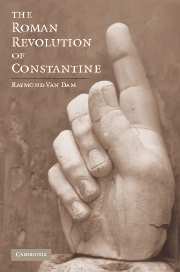Book contents
- Frontmatter
- Contents
- PREFACE
- ABBREVIATIONS
- Map
- Introduction: AUGUSTUS AND CONSTANTINE
- SECTION I A ROMAN EMPIRE WITHOUT ROME
- 1 CONSTANTINE'S RESCRIPT TO HISPELLUM
- 2 HIS FAVORITE ROOSTER: OLD ROME AND NEW ROME
- 3 “HOPE IN HIS NAME”: THE FLAVIAN DYNASTY
- 4 READING AHEAD
- SECTION II A GREEK ROMAN EMPIRE
- SECTION III EMPEROR AND GOD
- Epilogue: ONE EMPEROR
- APPENDIX 1 HISPELLUM: DATE, TEXT, AND TRANSLATION
- APPENDIX 2 ORCISTUS: DATES, TEXT, AND TRANSLATION
- EDITIONS AND TRANSLATIONS
- BIBLIOGRAPHY
- INDEX
3 - “HOPE IN HIS NAME”: THE FLAVIAN DYNASTY
Published online by Cambridge University Press: 05 June 2012
- Frontmatter
- Contents
- PREFACE
- ABBREVIATIONS
- Map
- Introduction: AUGUSTUS AND CONSTANTINE
- SECTION I A ROMAN EMPIRE WITHOUT ROME
- 1 CONSTANTINE'S RESCRIPT TO HISPELLUM
- 2 HIS FAVORITE ROOSTER: OLD ROME AND NEW ROME
- 3 “HOPE IN HIS NAME”: THE FLAVIAN DYNASTY
- 4 READING AHEAD
- SECTION II A GREEK ROMAN EMPIRE
- SECTION III EMPEROR AND GOD
- Epilogue: ONE EMPEROR
- APPENDIX 1 HISPELLUM: DATE, TEXT, AND TRANSLATION
- APPENDIX 2 ORCISTUS: DATES, TEXT, AND TRANSLATION
- EDITIONS AND TRANSLATIONS
- BIBLIOGRAPHY
- INDEX
Summary
During the third and early fourth centuries emperors may not have resided long or often in Rome, but they did not entirely neglect it either. The city and its empire were thought to have been synonymous from the beginning, and in the later fourth century one historian would credit Romulus, the mythical first king, as the founder of both Rome and the Roman empire. In this perspective the empire was as old as the city, and to rule one implied accepting responsibility for the other.
Despite their frequent military campaigns on the frontiers, during the later third century most emperors still acknowledged the prestige of Rome and patronized its inhabitants. When Maximian arrived in the late 290s, the “Roman people” mobbed him already outside the city's walls. When Diocletian visited in 303, he brought along spoils from the East, including thirteen elephants that had most likely been captured from the Persians. The culmination of this beneficial relationship was the announcement of the completion of the gigantic Baths of Diocletian in the north of the city, which Diocletian, Maximian, and the successor Tetrarchs dedicated to “their Romans.” These most recent emperors were now competing with the achievements of their predecessors in the one city with a long enough history of aristocratic munificence and imperial patronage to keep a scorecard. According to one retrospective survey, “each emperor, past and present, wanted to build something in Rome, and each of them constructed some sort of monument in his own name.”
- Type
- Chapter
- Information
- The Roman Revolution of Constantine , pp. 79 - 129Publisher: Cambridge University PressPrint publication year: 2007



